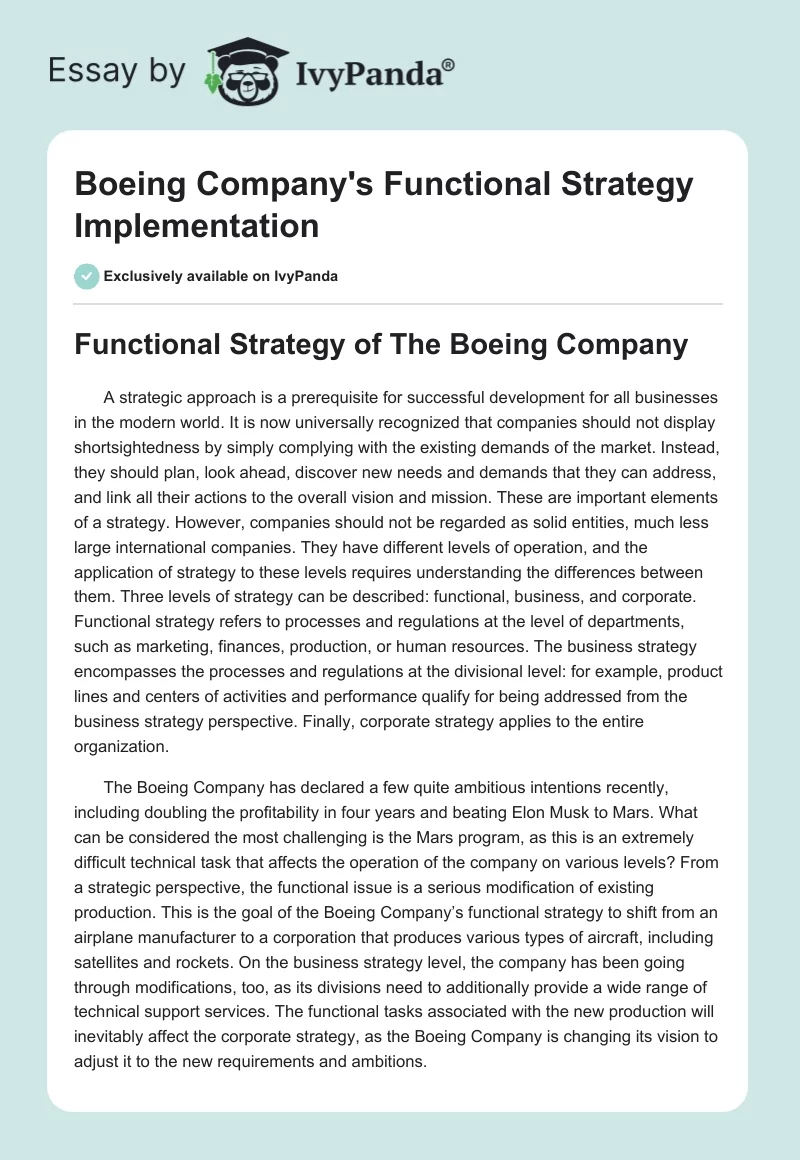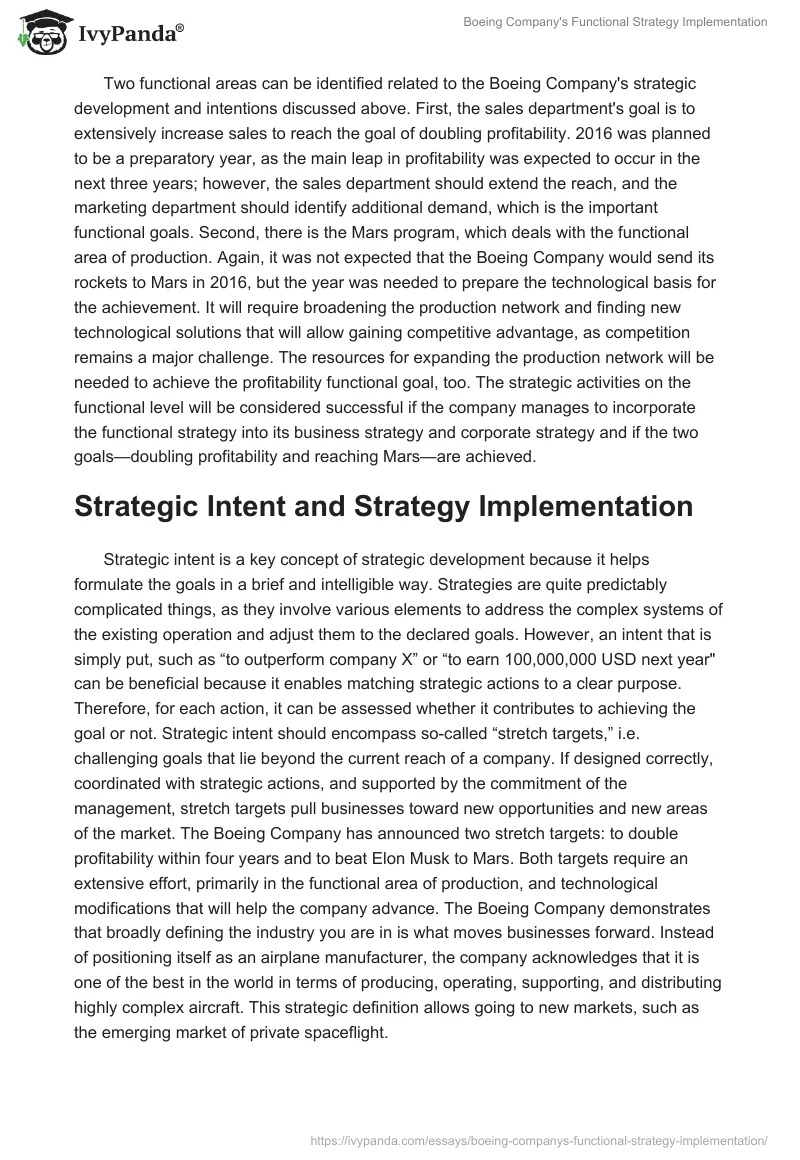Functional Strategy of The Boeing Company
A strategic approach is a prerequisite for successful development for all businesses in the modern world. It is now universally recognized that companies should not display shortsightedness by simply complying with the existing demands of the market. Instead, they should plan, look ahead, discover new needs and demands that they can address, and link all their actions to the overall vision and mission. These are important elements of a strategy.
However, companies should not be regarded as solid entities, much less large international companies. They have different levels of operation, and the application of strategy to these levels requires understanding the differences between them. Three levels of strategy can be described: functional, business, and corporate. Functional strategy refers to processes and regulations at the level of departments, such as marketing, finances, production, or human resources.
The business strategy encompasses the processes and regulations at the divisional level: for example, product lines and centers of activities and performance qualify for being addressed from the business strategy perspective. Finally, corporate strategy applies to the entire organization.
The Boeing Company has declared a few quite ambitious intentions recently, including doubling the profitability in four years and beating Elon Musk to Mars. What can be considered the most challenging is the Mars program, as this is an extremely difficult technical task that affects the operation of the company on various levels? From a strategic perspective, the functional issue is a serious modification of existing production. This is the goal of the Boeing Company’s functional strategy to shift from an airplane manufacturer to a corporation that produces various types of aircraft, including satellites and rockets.
On the business strategy level, the company has been going through modifications, too, as its divisions need to additionally provide a wide range of technical support services. The functional tasks associated with the new production will inevitably affect the corporate strategy, as the Boeing Company is changing its vision to adjust it to the new requirements and ambitions.
Two functional areas can be identified related to the Boeing Company’s strategic development and intentions discussed above. First, the sales department’s goal is to extensively increase sales to reach the goal of doubling profitability. 2016 was planned to be a preparatory year, as the main leap in profitability was expected to occur in the next three years; however, the sales department should extend the reach, and the marketing department should identify additional demand, which is the important functional goals.
Second, there is the Mars program, which deals with the functional area of production. Again, it was not expected that the Boeing Company would send its rockets to Mars in 2016, but the year was needed to prepare the technological basis for the achievement. It will require broadening the production network and finding new technological solutions that will allow gaining competitive advantage, as competition remains a major challenge. The resources for expanding the production network will be needed to achieve the profitability functional goal, too. The strategic activities on the functional level will be considered successful if the company manages to incorporate the functional strategy into its business strategy and corporate strategy and if the two goals—doubling profitability and reaching Mars—are achieved.
Strategic Intent and Strategy Implementation
Strategic intent is a key concept of strategic development because it helps formulate the goals in a brief and intelligible way. Strategies are quite predictably complicated things, as they involve various elements to address the complex systems of the existing operation and adjust them to the declared goals. However, an intent that is simply put, such as “to outperform company X” or “to earn 100,000,000 USD next year” can be beneficial because it enables matching strategic actions to a clear purpose. Therefore, for each action, it can be assessed whether it contributes to achieving the goal or not. Strategic intent should encompass so-called “stretch targets,” i.e. challenging goals that lie beyond the current reach of a company. If designed correctly, coordinated with strategic actions, and supported by the commitment of the management, stretch targets pull businesses toward new opportunities and new areas of the market.
The Boeing Company has announced two stretch targets: to double profitability within four years and to beat Elon Musk to Mars. Both targets require an extensive effort, primarily in the functional area of production, and technological modifications that will help the company advance. The Boeing Company demonstrates that broadly defining the industry you are in is what moves businesses forward. Instead of positioning itself as an airplane manufacturer, the company acknowledges that it is one of the best in the world in terms of producing, operating, supporting, and distributing highly complex aircraft. This strategic definition allows going to new markets, such as the emerging market of private spaceflight.
Strategy implementation can be regarded from the “who, what, and how” perspective.
The strategic intent described above implies a significant leap for the Boeing Company, which is why strategic modifications should be applied to all the levels of the company. It requires a remarkable effort, which is why it is suggested to establish a new unit on the corporate level to coordinate all the activities and their correlations with the strategic intent. The unit is the Office of Strategy Management (OSM). Strategy managers are the “who” in the necessary strategic activities.
The “what” part of strategic implementation is the operation of the OSM. The Office will be different from other corporate units involved in strategic planning because it will have the authority for strategic execution. Achieving the strategic intent will require a lot of modifications in the production area, and they all need to be coordinated by the OSM and matched to the strategic goals. Nonstrategic investments and programs should be eliminated.
The “how” part of strategic implementation refers to the system of interaction that needs to be adopted for the implementation to be carried out successfully. The recommended system implies that the OSM should be close to the board to directors: the former is responsible for the highest level of strategic activities (the corporate level), and the latter is a principal decision-maker, which is why their activities should be coordinated. However, the OSM should be even closer to the functional area of production, as this is where the functional strategy is implemented, affecting the higher levels. The OSM does not merely monitor or report: it ensures the execution of strategic measures and coordinates the motion of strategic measures from lower levels to higher ones and vice versa.
Evaluation and Control
Kaplan and Norton’s classical concept of the balanced scorecard suggests adding to the financial perspective three more perspectives of performance evaluation: customer, internal operation, and learning and growth. From the financial perspective, the Boeing Company has the objective to have more international contracts, which will enhance the international presence and network of cooperation and reduce the dependence on current customers. From the customer perspective, there is the objective to reach new audiences, which requires an effort from the company’s marketers and will help discover new demand to move the business forward.
From the internal operation perspective, one of the objectives is to increase environmental initiatives, which will involve research and technological modifications based on recommendations on reducing environmental impact and adopting more sustainable practices. From the learning and growth perspective, the Boeing Company has set the ambitious objective of technological leadership, which can be achieved through encouraging diversity, feedback, and ideas aimed at bringing innovation and committing to constant development by pursuing stretch targets.
It is important that the scorecard not only helps evaluate the performance but also facilitates the strategic development of corporations because it promotes adjusting everything the corporations do to their strategic goals. For the Boeing Company, the corporate balanced scorecard will feature the following elements:
- Finances
- The number of international contracts
- Environmental costs (including fines)
- Employment efficiency
- Customer Perspective
- Reaching new audiences
- Increasing market share
- Increasing customer loyalty and satisfaction
- Internal Operation
- Environmental initiatives
- Core competency promotion
- Corporate citizenship awareness
- Learning and Growth
- Technological leadership
- Encouraging diversity and creativity
- Leadership programs


